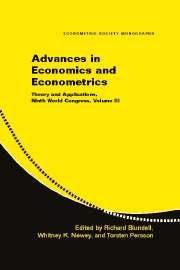Book contents
- Frontmatter
- Contents
- Contributors
- Introduction by the Editors
- 1 Identification of Nonadditive Structural Functions
- 2 Nonadditive Models with Endogenous Regressors
- 3 Heterogeneity and Microeconometrics Modeling
- 4 Heterogeneous Choice
- 5 Modeling Heterogeneity
- 6 Inference with Weak Instruments
- 7 Empirical Likelihood Methods in Econometrics: Theory and Practice
- 8 Weak Instruments and Empirical Likelihood: A Discussion of the Papers by D. W. K. Andrews, J. H. Stock, and Y. Kitamura
- 9 Estimating Continuous-Time Models with Discretely Sampled Data
- 10 Variation, Jumps, and High-Frequency Data in Financial Econometrics
- 11 Discussion of Aït-Sahalia and Barndorff-Nielsen and Shephard
- 12 Understanding Bias in Nonlinear Panel Models: Some Recent Developments
- 13 Fixed and Random Effects in Nonlinear Panel Data Model: A Discussion of a Paper by Manuel Arellano and Jinyong Hahn
- Index
- Titles in the series
3 - Heterogeneity and Microeconometrics Modeling
Published online by Cambridge University Press: 05 January 2013
- Frontmatter
- Contents
- Contributors
- Introduction by the Editors
- 1 Identification of Nonadditive Structural Functions
- 2 Nonadditive Models with Endogenous Regressors
- 3 Heterogeneity and Microeconometrics Modeling
- 4 Heterogeneous Choice
- 5 Modeling Heterogeneity
- 6 Inference with Weak Instruments
- 7 Empirical Likelihood Methods in Econometrics: Theory and Practice
- 8 Weak Instruments and Empirical Likelihood: A Discussion of the Papers by D. W. K. Andrews, J. H. Stock, and Y. Kitamura
- 9 Estimating Continuous-Time Models with Discretely Sampled Data
- 10 Variation, Jumps, and High-Frequency Data in Financial Econometrics
- 11 Discussion of Aït-Sahalia and Barndorff-Nielsen and Shephard
- 12 Understanding Bias in Nonlinear Panel Models: Some Recent Developments
- 13 Fixed and Random Effects in Nonlinear Panel Data Model: A Discussion of a Paper by Manuel Arellano and Jinyong Hahn
- Index
- Titles in the series
Summary
INTRODUCTION
There is general agreement that there is a good deal of heterogeneity in observed behavior. Heckman in his Nobel lecture (Heckman, 2001) states: “the most important discovery [from the widespread use of micro-data is] the evidence on the pervasiveness of heterogeneity and diversity in economic life.” This is true but to see it in print as a “discovery” is a surprise since we have internalized it so thoroughly and it is now second nature for anyone working with microdata to consider heterogeneity.
We have been unable to find a consensus definition of heterogeneity. A definition we suggest (which derives from Cunha, Heckman, and Navarro, 2005) is that heterogeneity is the dispersion in factors that are relevant and known to individual agents when making a particular decision. Latent heterogeneity would then be those relevant factors that are known to the agent but not to the researcher. The heterogeneity could be differences in tastes, beliefs, abilities, skills, or constraints. Note that this definition does not impose that heterogeneity is constant over time for a given individual nor that because something is fixed and varies across the population that it is necessarily heterogeneous. Examples of the former would be changing information sets and an example of the latter would be, say, some genetic factor which impacts on outcomes but which is unobserved by any agent. Thus a “fixed effect” in an econometric model may or may not be consistent with heterogeneity, as defined here.
Our definition of heterogeneity distinguishes it clearly from uncertainty, measurement error, and model misspecification that are other candidates for the variation we see around the predictions of a given deterministic model.
- Type
- Chapter
- Information
- Advances in Economics and EconometricsTheory and Applications, Ninth World Congress, pp. 47 - 74Publisher: Cambridge University PressPrint publication year: 2007
- 7
- Cited by



